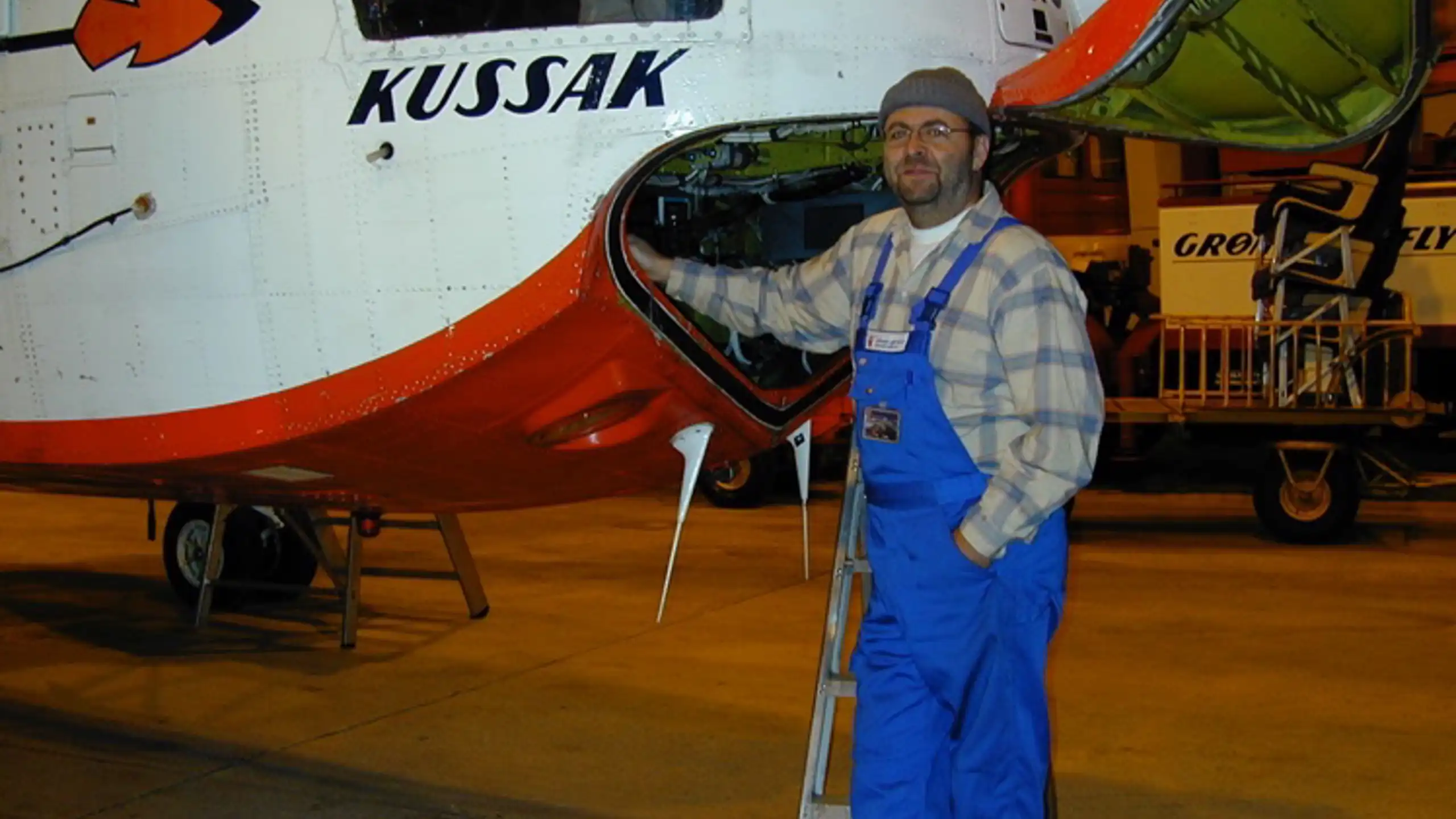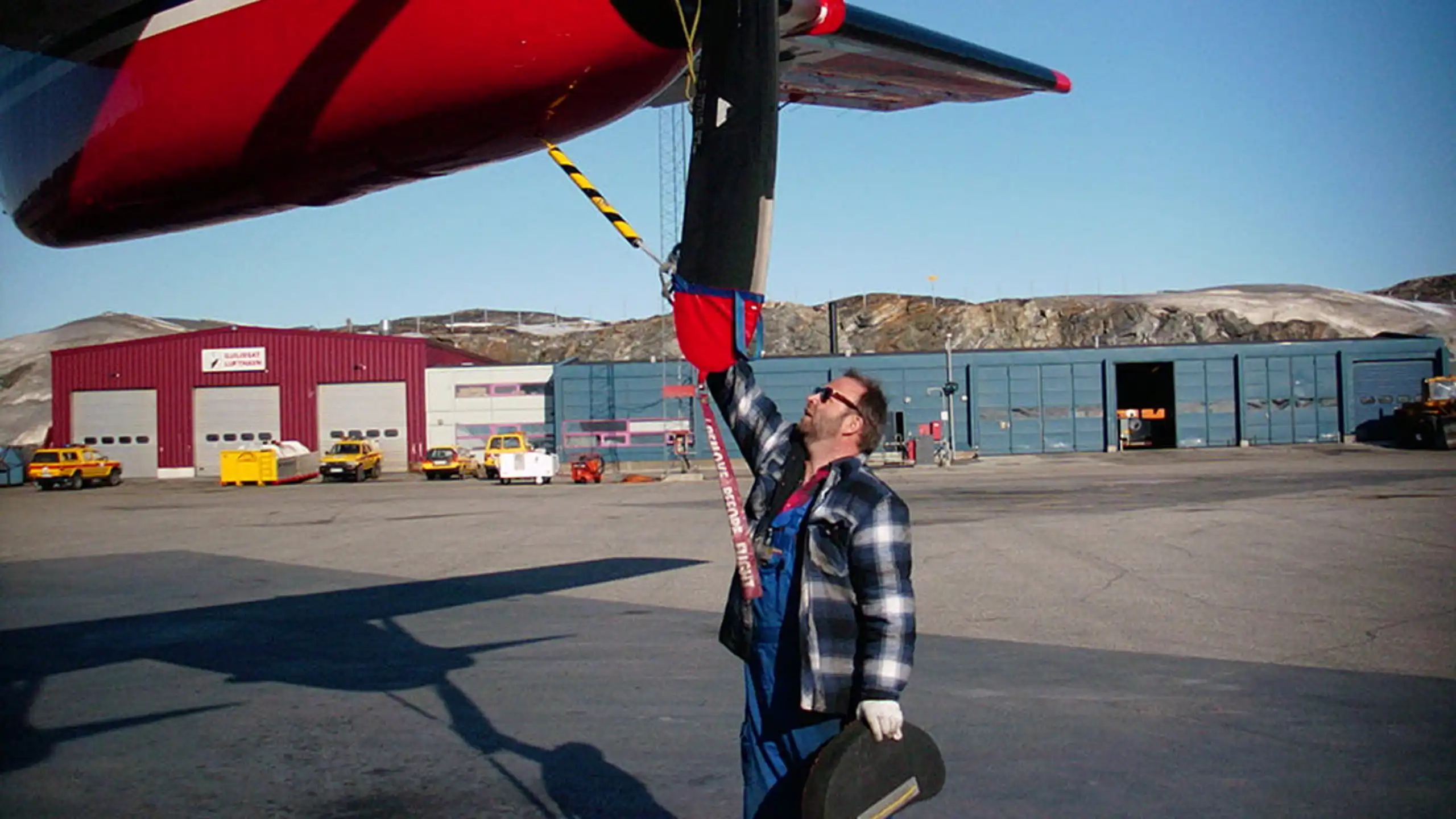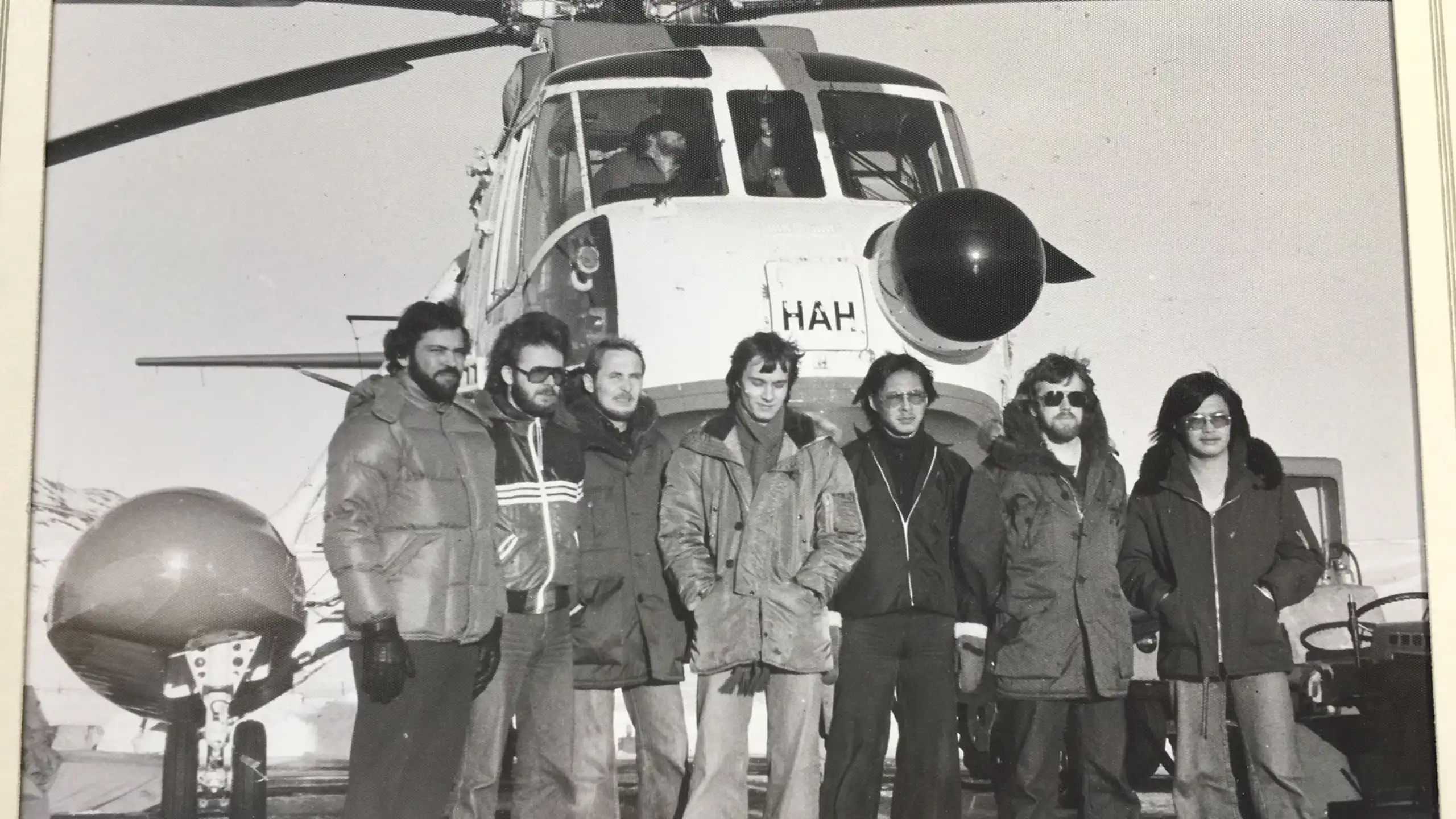Thursday, August 1, 2024

50-year anniversary: - An exciting working life
Ingemar Andersson, 67, is the first employee and mechanic in Air Greenland's history to celebrate his 50th anniversary. In this portrait, you can read his exciting stories about his many experiences over the years.
Ingemar was born in 1956 in Sweden and lived there until he was 11 years old, when the family moved to Funen. Ingemar's father was an air force pilot in Sweden and got a job in Denmark as a helicopter pilot. After a few years in Denmark, the family moved to Greenland. Ingemar's father had gotten a job at Grønlandsfly and flew as an S61 pilot in the 70s and 80s, where father and son flew together several times.
Ingemar graduated from the Seminary School in Godthåb (now: Nuuk) in 1973. He then attended a boarding school in Denmark, but got tired of school and returned to Godthåb. Here he had various odd jobs until the opportunity for an apprenticeship at Grønlandsfly arose on August 1, 1974. It was the start of a long adventure.
After 3.5 years of practical training at the heliport and three periods of theory at SAS in Kastrup, he was trained on February 1, 1978.
S61 tied Greenland together
The adventure started right after he completed his training. He took a type course on the S61 helicopter, which made him a flying mechanic and flew up and down the West Coast for the next three years.
- I have a special relationship with the S61. Partly because it was the first helicopter I got to know, and partly because it was a special life to be a flying mechanic. Back then, the S61 tied Greenland together until new airports and the Dash7 took over.
- With the S61 I got to know the country. The mechanic was on board as cabin attendant, so we could check and service the helicopter in any situation, no matter where it was, says Ingemar.
During the same period, he had several offshore periods with Greenlandsfly's own S61s in Norway and Canada and a single period in Alaska, because there was a surplus of S61s after the airport in Nuuk opened in 1979. But the adventure doesn't stop there.
A string of experiences
Ingemar has flown planes and helicopters around the island, met polar bears, helped the Sirius patrol, been on Hans Ø, on mountain tops to secure the radio chain and thus telecommunications in West Greenland and been on a dinosaur hunt in Northeast Greenland.
- It's been a very exciting and varied working life, and I'll continue for a while yet,” says the 50-year-old, who lives in Copenhagen and works four weeks on and four weeks off.
Ingemar has mainly worked with helicopters and has also spent a few years with Dash7. But he started working on the S61, continued on the Bell 212, Bell 206 and AS350.
Today, Ingemar works on our H155 helicopter and is a station mechanic at Pituffik Space Base, where he is happy to be.
His many years of service have included a wide range of exciting charter assignments. Especially in the desolate Northeast Greenland, but also in North Greenland. Once in the early 1990s, they had to come to the rescue of Greenland adventurer Peter Brandt and his fellow travelers when they were on their way around Greenland in a cow boat and on skis, completely without engine power. The expedition had to be cut short and they were flown to Alert, a military station in northernmost Canada, as they were in distress.
Ingemar has helped lay out depots for Sirius, been on a dinosaur hunt in Carlsberg Fjord and been on assignments for glacier geeks in several parts of the country.
- In the early 90s, I helped rescue the Sirius patrol in JP Koch Fjord in North Greenland. They couldn't move on with the sledge due to a lack of snow,” says Ingemar and continues.
- “We flew out with our Bell 212 from Thule Air Base, as it was called then, and had to fly twice to get all the equipment and dogs. Sirius' dogs were big and took up a lot of space in the 212's cabin.
They were flown to a gravel airstrip where an Icelandic Twin Otter was to take over. But we had to go back to get Sirius' sled, because the two Sirius people wouldn't fly without their sled also coming with the Twin Otter,” he says.
Encounter with a polar bear
On a charter assignment in Thule in the early 90s, he had a close encounter with a polar bear on the Carey Islands, which was hidden behind a snowdrift.
- When we landed, I jumped out of the helicopter, ran 50 meters ahead to film a shut down with my new camera. What I didn't know was that there was a polar bear watching me and the helicopter - 40 meters from me, says Ingemar.
Fortunately, the polar bear disappeared in the opposite direction thanks to shouts and screams from the pilot and charter customers.
- It wasn't until the evening that I realized that I had been in danger. At that moment I concentrated on filming and managed to film the polar bear and say: 'Here we have a polar bear',” he laughs.
Over the years, Ingemar has also been on numerous Tele stations on the radio chain. This was with S61 and Bell 212 from Nanortalik in the south to Upernavik in the north and locally in the Qaanaaq area, where they flew to Pearys Varde and Politikens Bræ, where telesites were located at the time, and to the relay station on Herbert Ø. He has also visited DMI's weather stations in North Greenland with Iscentralens Twin Otter.
Ingemar has been to Hans Island in the Nares Strait between Greenland and Canada a few times. An island that has been in dispute for many years, but which the two countries have now agreed to share.
- I flew with a Swedish pilot. When we got to the island, we had to see if there was an Old Danish or a Canadian Club in the cairn - and see who had been there last. The flag at the cairn was so battered that we couldn't tell if it was Danish or Canadian,” says Ingemar and continues;
- “We thought it would be fun to raise the Swedish flag and put a bottle of OP Anderson (Swedish schnapps, ed.) in the cairn. Unfortunately, we didn't have either, so instead we had a good laugh at the thought of what the Danes and Canadians would have said if they saw a Swedish flag on the flagpole on Hans Ø, laughs Ingemar.
Japanese on thin ice
As a mechanic, Ingemar has also participated in many search and rescue operations and has helped save lives with both the S61 and Bell 212.
- Back then, SAR tasks were handled by the nearest helicopter, which was taken out of service when the alarm sounded. Most missions ended well, but there were also a few without a happy ending. I remember one person with food poisoning who didn't survive the trip. Another evacuation was a pregnant woman who gave birth on board with a stillborn child. It was deeply tragic and affected us all,” he says.
But fortunately, critical rescues also end well, such as seven or eight years ago when a young Japanese man who had visited the famous Japanese Ikuo Oshima in Siorapaluk wanted to ski from Siorapaluk to Savissivik with equipment on a sled. A distance of over 250 kilometers.
It was spring and there was still sea ice, but off Steensby Land there is unsafe ice due to currents. The Japanese man fell through the ice and into the water, but he managed to get onto the thin ice.
- However, the ice could not support him, so he had to crawl into the small plastic sledge. He managed to get dry clothes and sleeping bag out of the waterproof bags and change clothes in the sleeping bag. He had a satellite phone with him, but his fingers were so frozen that he couldn't operate it. So he sat curled up in the fetal position all night and stayed awake so he didn't freeze to death,” says Ingemar.
By morning, his fingers had thawed enough to press the emergency button that alerted Arctic Command. And the helicopter on base was contacted.
- We were in the hangar at our Bell 212 when we got the alert. The pilot, myself and the station manager flew off immediately towards his position. As we came around the point, we could see him immediately. The only black spot on the ice at the given position. We hadn't hoisted and the ice was too thin for us to land on.
The pilot was able to keep the helicopter just above the thin ice, next to the injured Japanese. Ingemar climbed out on the ski with a lifeline around his waist, held by the station manager, while Ingemar held on to the doorway with one hand.
- The Japanese man was curled up in his sleeping bag and wasn't moving, so I thought he was dead. When I tapped him on the shoulder, he turned his head and looked at me in wonder,” Ingemar says, and continues;
- “We got him into the cabin, along with his sled and equipment, while I stood on the ski. He was very badly injured and was given a warm parka and flown to the base where an ambulance was waiting. We were happy that the mission was successful.
- The next day, while we were in the hangar, he came by and picked up his equipment that we had hung to dry the day before. It was amazing that he had made it through without injury and we were happy to see him safe and sound.
- The Japanese man bought a ticket back to Qaanaaq and was flown there the next day with all his equipment, says Ingemar about one of many rescue missions in the harsh nature of the Thule area.
Station Mechanic
For most of his time at Air Greenland, Ingemar has been a station mechanic.
In his own words, he says that he has been at almost every station for shorter or longer periods of time.
- As a station mechanic, you are responsible for the aircraft assigned to the station and that they are ready for the planned flight program.
- This involves daily inspections, troubleshooting, repairs, all according to the manufacturer's instructions, as well as keeping the aircraft and station in a condition that meets regulatory requirements. For major work or critical component replacements, help is requested from the main base in Nuuk, he explains and adds:
- “Air Greenland has many stations with fixed-wing aircraft and helicopters, and as it can be difficult to attract permanent residents in many places, we work on a fixed rotation, with 4 weeks on 4 weeks off.
Happy with his work
Ingemar has enjoyed working in Air Greenland's technical department all these years, just as he has enjoyed living in different places in Greenland.
- “I have been part of an incredibly exciting development, where Grønlandsfly/Air Greenland has had to adapt to the changing conditions required by the technical development, the economy, the increased traffic and passenger volume. I think we have always focused on making things as good as possible for everyone throughout the country, as well as ensuring that safety on the planes is top notch.
- It was completely different in 1974, when the country was bound together by eight S61s, compared to today, where airports and fixed-wing aircraft perform the tasks, and helicopters perform local transportation tasks between larger and smaller cities and to and from settlements, especially in remote areas. “We are station mechanics today and rarely fly around, but we take care of the planes that fly between the stations and the helicopters that fly out and home,” he says.

Ingemar prepares a Dash7 in Ilulissat in 2000, where he was a station mechanic. Photo: Kaj Siegstad

Ingemar is currently a station mechanic at Pituffik Space Base. It's a job he enjoys and would like to continue doing even though he has reached retirement age. Photo: Selfie

1978: Privat foto

Kangerlussuaq 2018 S-61N OY-HAG rotor blade pressure test. Photographer Steen Berthelsen

Ingemar at an S-61 in Ilulissat in 2000. The first helicopter type he serviced as a mechanic and which he flew around with as a flying mechanic. Photo: private
FAKTA: Karrieren
1982-83:
Stationsmekaniker i Kangerlussuaq på Dash7 og S61 på en 30/30 ordning.
1. august 1984: Ansat som mester i teknisk afdeling, og flyttede til Nuuk
1987-89:
Teknisk leder i GLACE, Grønlandsflys datterselskab, som løste charteropgaver og bygdetrafik.
Da GLACE blev nedlagt overgik han til en stilling som mekaniker på Bell 212, igen på en 30/30 ordning.
1994:
Stationsmekaniker i Ilulissat på Dash7 og S61
2002:
Stationsmekaniker i Narsarsuaq på S61 og AS350 indtil 2012
2013:
Thule Air Base på Bell 212 og fra 2022 på den nyere Airbus helikopter EC155 - kun afbrudt af enkelte år i Tasiilaq, Nuuk og Upernavik.
